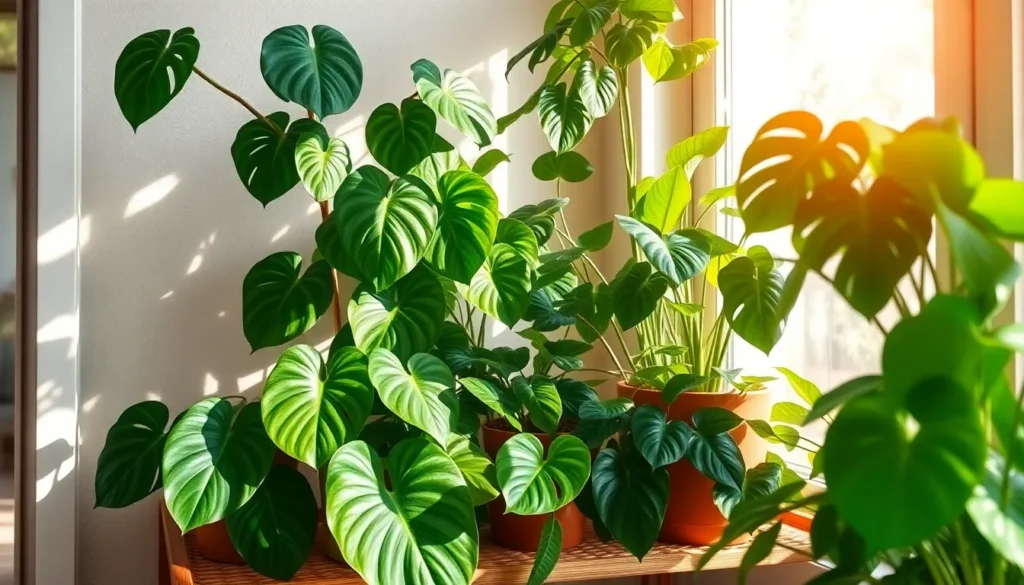Heart-shaped foliage captures our attention like no other plant feature. These charming leaves create an instant emotional connection that transforms any space into a romantic sanctuary. We’ve discovered that plants with heart-shaped leaves aren’t just visually stunning – they’re surprisingly diverse and perfect for every gardening skill level.
From the dramatic climbing Monstera deliciosa to the delicate trailing Pothos, heart-leafed plants offer endless possibilities for your indoor and outdoor gardens. We’re excited to share how these botanical beauties can elevate your plant collection while bringing natural charm to your home.
Whether you’re a seasoned plant parent or just starting your green journey, understanding which heart-shaped leaf varieties thrive in different conditions will help you create the perfect plant paradise. Let’s explore these captivating specimens that prove nature truly knows how to steal our hearts.
Heart-Shaped Leaf Plants That Will Make Your Home Feel More Romantic
Romance flourishes when we surround ourselves with plants that speak the language of love through their naturally sculpted foliage. These heart shaped leaf varieties transform any living space into an intimate sanctuary where affection blooms alongside botanical beauty.
Anthurium creates an atmosphere of passionate elegance with its glossy, deep green heart shaped leaves and vibrant red or pink flowers. We’ve found this tropical beauty thrives in bright, indirect light and adds instant sophistication to bedrooms and living rooms. Its waxy leaves catch light beautifully, creating romantic shadows that dance across walls throughout the day.
Philodendron hederaceum cascades gracefully from hanging baskets, its trailing vines adorned with perfect heart shaped leaves that seem to whisper sweet nothings as they sway. This low maintenance charmer tolerates various lighting conditions and forgives occasional watering lapses, making it ideal for busy couples who still want romantic greenery in their homes.
Hoya kerrii stands as nature’s own Valentine with its succulent heart shaped leaves that earned it the nickname “Sweetheart Plant.” We recommend placing single leaf cuttings on windowsills or desks as living love notes that remind us of special relationships. These drought tolerant beauties require minimal care while maximizing romantic impact.
Cyclamen brings seasonal romance indoors with its silver marbled heart shaped leaves and delicate flowers in shades of pink, white, and red. During cooler months, we position these beauties near windows where their distinctive foliage creates intimate lighting effects. Their compact size makes them perfect for creating romantic tablescapes or bedside displays.
Caladium transforms rooms with its dramatic heart shaped leaves painted in romantic hues of pink, white, and green. We’ve discovered these tropical stunners work beautifully as temporary houseplants, bringing bold romantic flair to dining rooms and entryways. Their artistic foliage patterns create natural conversation starters for romantic evenings at home.
Pothos: The Perfect Beginner’s Heart-Shaped Houseplant
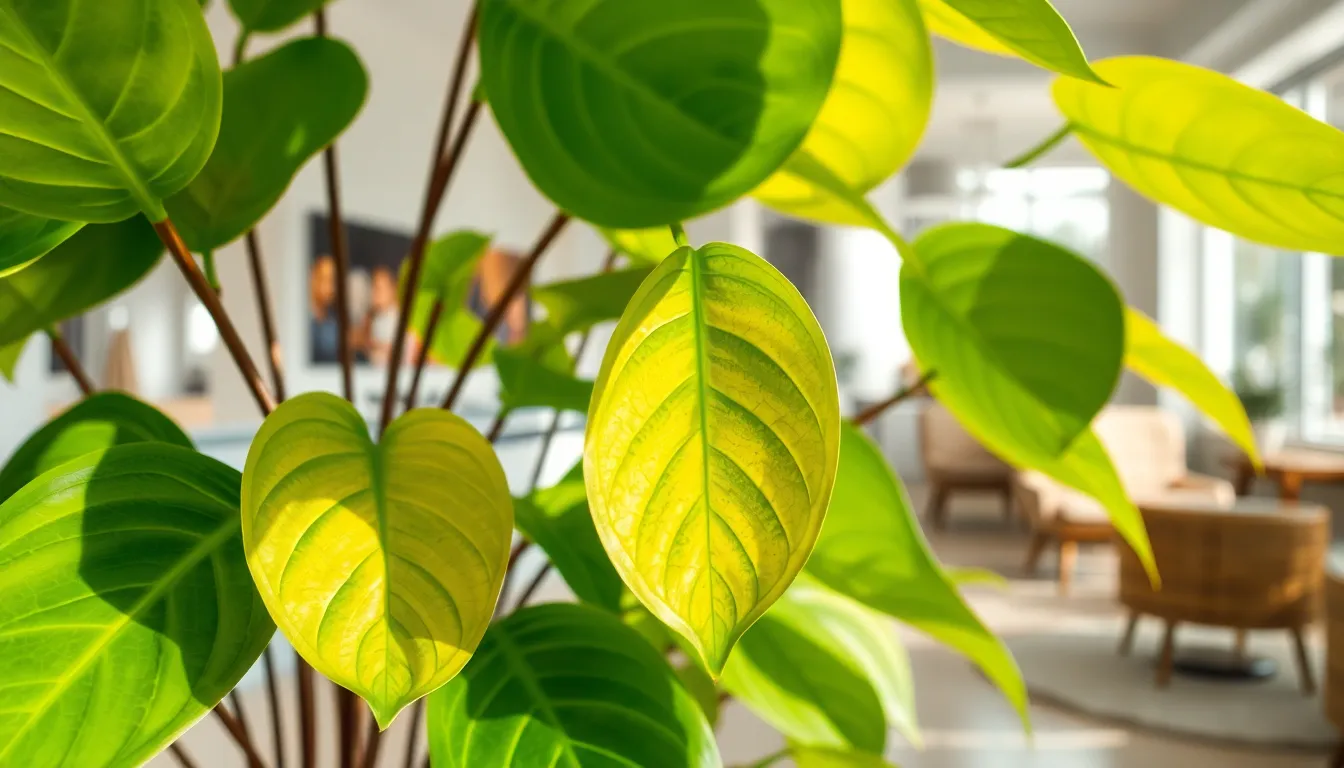
We can’t overlook Pothos (Epipremnum aureum) when discussing heart-shaped houseplants that make perfect starting points for new plant parents. This resilient beauty offers stunning heart-shaped leaves while requiring minimal care to thrive.
Golden Pothos Varieties
Golden Pothos showcases the classic heart-shaped foliage that makes this plant so beloved among indoor gardeners. Its vibrant green leaves feature beautiful golden variegation that brightens any space, making it an ideal choice for offices, living rooms, and bedrooms.
Classic Golden Pothos grows rapidly in various lighting conditions, from low-light corners to bright indirect spots. The trailing vines can extend several feet long, creating dramatic cascading displays when grown in hanging baskets or allowed to climb moss poles.
Marble Queen and Snow Queen Options
Marble Queen Pothos presents striking white and green variegation across its heart-shaped leaves, creating an elegant marbled appearance. This variety grows more slowly than its golden cousin but offers exceptional visual appeal with its creamy white patterns.
Snow Queen Pothos features even more pronounced white variegation, with some leaves appearing almost entirely white with green accents. The heart-shaped foliage creates stunning contrast against darker backgrounds, making it perfect for modern interior designs.
Both varieties require slightly brighter light conditions to maintain their distinctive variegation patterns, though they’ll still tolerate lower light situations better than most houseplants.
Care Tips for Thriving Pothos Plants
Lighting requirements for Pothos remain flexible, as these heart-shaped beauties adapt to conditions from low to bright indirect light. Avoid direct sunlight which can scorch the delicate leaves and fade their beautiful variegation.
Watering should occur when the top inch of soil feels dry to the touch, typically every 7-10 days depending on your home’s humidity levels. Overwatering causes more problems than underwatering with these forgiving plants.
Temperature preferences range between 65°F to 75°F (18°C to 24°C), making them perfect for typical indoor environments. Keep your Pothos away from cold drafts, heating vents, and air conditioning units to prevent stress.
Philodendron: Classic Heart-Shaped Leaves for Any Space
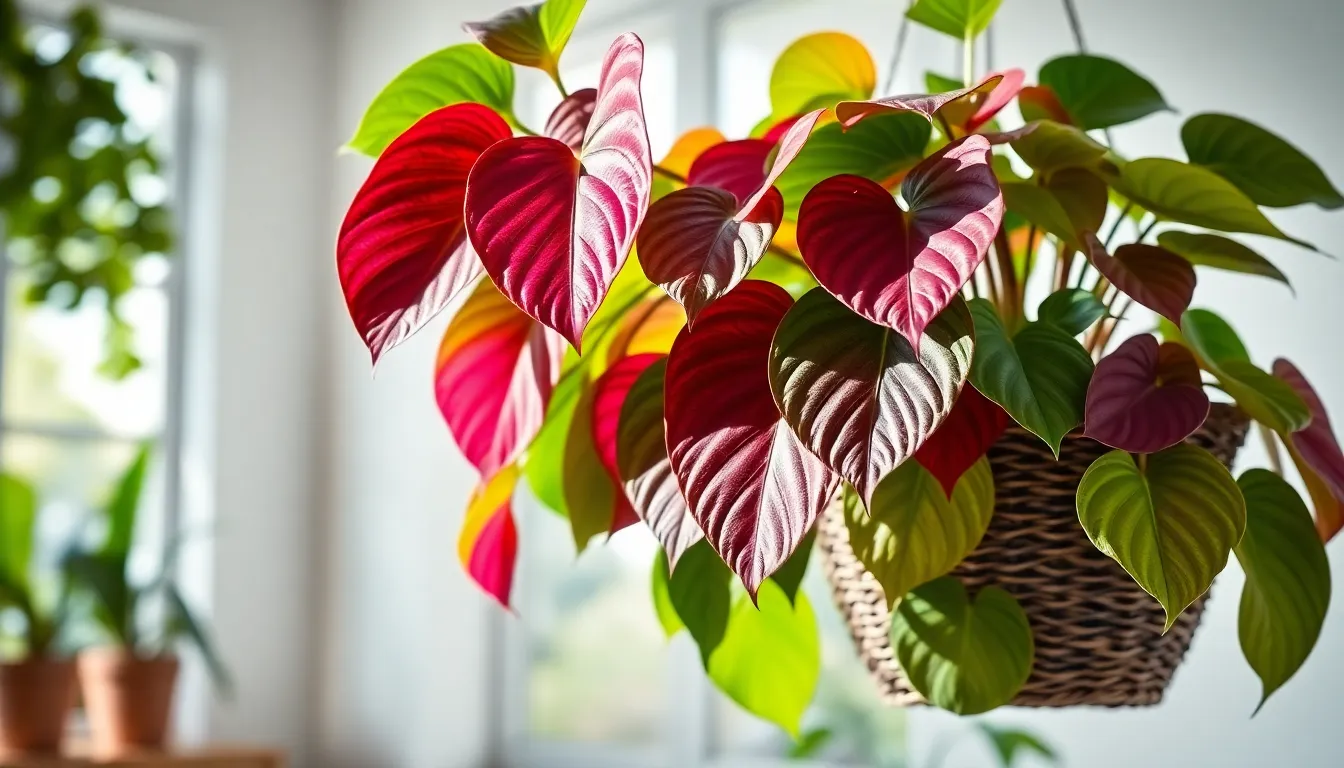
Philodendrons represent some of the most beloved heart-shaped houseplants available today. We’ll explore these versatile plants that bring natural beauty to any indoor environment.
Heartleaf Philodendron Characteristics
Heartleaf Philodendron (Philodendron hederaceum) showcases the classic heart-shaped leaves that make these plants so appealing. Each leaf displays a distinctive cordate shape with glossy green surfaces that catch light beautifully. Vines cascade gracefully from hanging baskets or climb support structures with ease.
Growth patterns vary depending on placement and care. Trailing varieties can reach several feet in length when allowed to hang freely. Climbing versions use aerial roots to attach to moss poles or other supports naturally.
Leaf sizes typically range from 2 to 4 inches across at maturity. New growth emerges as smaller heart shapes that expand over time. The waxy texture of mature leaves helps the plant retain moisture efficiently.
Pink Princess and Brazil Varieties
Pink Princess Philodendron features stunning pink variegation that creates dramatic contrast against deep green foliage. Each leaf displays unique pink patterns that range from subtle blushes to bold splashes of color. This variety commands higher prices due to its striking appearance and slower growth rate.
Brazil Philodendron offers bright yellow and green striped patterns that resemble the Brazilian flag colors. Variegation appears as irregular stripes or patches across each heart-shaped leaf. New growth often shows more pronounced coloring that may fade slightly with age.
Both varieties maintain the classic heart shape while adding exceptional visual interest. Propagation remains straightforward through stem cuttings placed in water or soil. These colorful varieties require similar care to standard heartleaf philodendrons.
Light and Watering Requirements
Bright, indirect light provides optimal growing conditions for all philodendron varieties. We recommend placing plants near east or north-facing windows where they receive gentle morning sun or filtered daylight. Direct sunlight can scorch the delicate heart-shaped leaves and cause permanent damage.
Well-draining soil prevents root rot while maintaining adequate moisture levels. Standard potting mix combined with perlite or orchid bark creates the ideal growing medium. Containers must have drainage holes to allow excess water to escape freely.
Moderate watering schedules work best for consistent growth and health. We suggest checking soil moisture by inserting your finger 1-2 inches deep into the potting mix. Water thoroughly when the top layer feels dry but the deeper soil remains slightly moist.
| Care Aspect | Requirement | Frequency |
|---|---|---|
| Light | Bright, indirect | Daily exposure |
| Watering | Moderate moisture | 1-2 times weekly |
| Soil | Well-draining mix | Refresh annually |
| Temperature | 65-80°F range | Year-round |
Anthurium: Glossy Heart-Shaped Leaves with Stunning Flowers
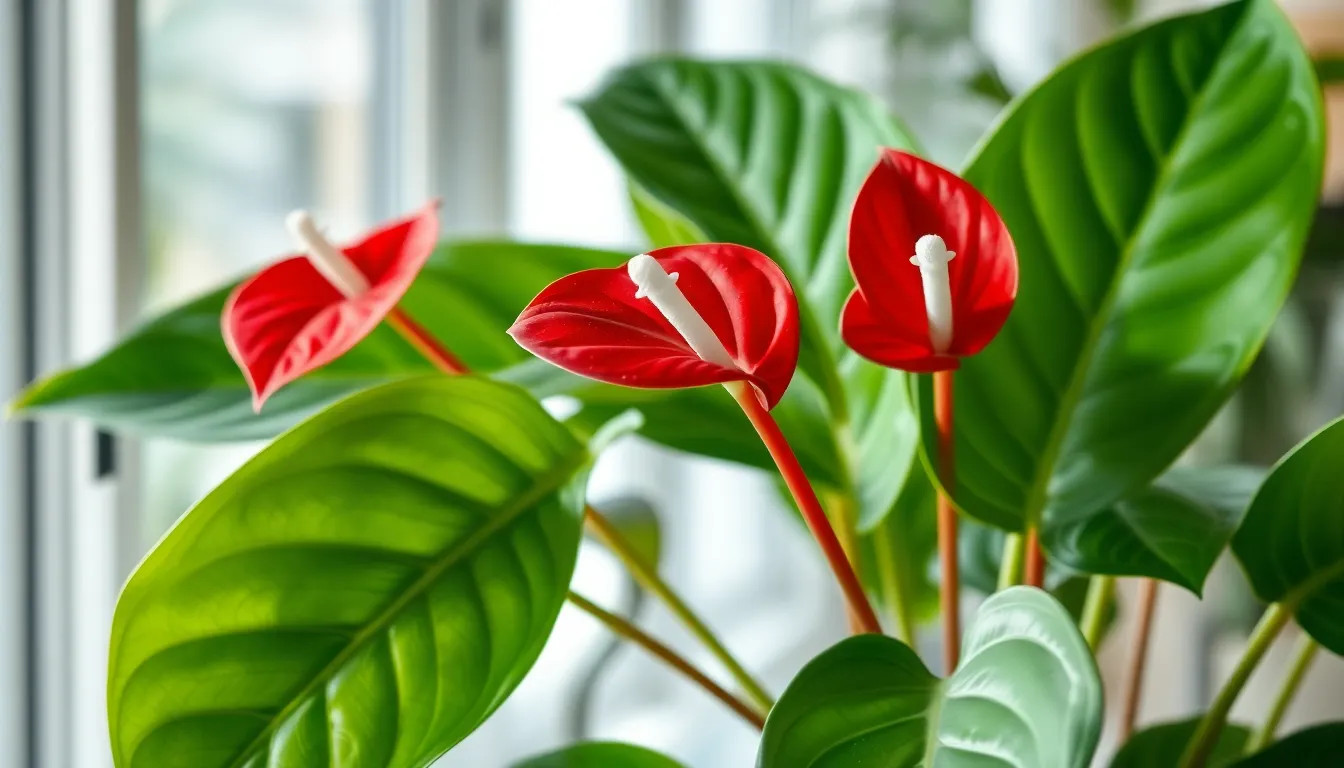
Anthurium stands out among heart-shaped leaf plants with its distinctive glossy foliage and remarkable flowering capabilities. We love how this tropical beauty combines attractive heart-shaped leaves with long-lasting, vibrant blooms that make it a showstopper in any indoor collection.
Flamingo Flower Features
Flamingo flowers showcase a unique wax-like texture that distinguishes them from other flowering houseplants. We appreciate how these blooms maintain their stunning appearance for weeks, making Anthurium an excellent choice for those seeking long-lasting floral displays. The flowers feature a distinctive spadix (the central spike) surrounded by a colorful spathe that creates the heart-shaped appearance we adore.
Each bloom typically lasts 6 to 8 weeks when properly cared for, giving us extended enjoyment from every flowering cycle. The waxy surface of the flowers helps them resist wilting and maintains their fresh appearance throughout their blooming period. We find that the glossy leaves complement the flowers perfectly, creating an elegant contrast between the deep green foliage and vibrant blooms.
Color Variations and Bloom Patterns
Anthurium flowers offer an impressive spectrum of colors including red, pink, white, and purple varieties. We’re fascinated by how different cultivars can produce single-colored blooms or display multiple color combinations within the same flower. Red varieties remain the most popular choice, symbolizing love and passion, while pink options provide a softer romantic touch.
White Anthuriums create elegant displays that complement any décor style, and purple varieties add dramatic flair to our plant collections. Some cultivars feature color gradients where the spathe transitions from one hue to another, creating stunning ombre effects. We notice that flower colors can intensify or fade slightly based on lighting conditions and plant maturity.
Humidity and Temperature Needs
Anthurium thrives in high humidity environments, requiring 60% to 80% humidity levels for optimal growth and flowering. We recommend using humidity trays, room humidifiers, or grouping plants together to achieve these moisture levels indoors. Temperature consistency between 65°F to 75°F (18°C to 24°C) ensures healthy development and continuous blooming cycles.
These tropical plants struggle in dry indoor air, so we suggest misting the leaves regularly or placing them in naturally humid areas like bathrooms with adequate light. Temperatures below 60°F can stress the plant and reduce flowering, while excessive heat above 80°F may cause leaf burn. We find that maintaining stable environmental conditions results in more frequent blooming and healthier overall plant growth.
Cyclamen: Delicate Heart-Shaped Leaves with Seasonal Blooms

Cyclamen captivates gardeners with its distinctive heart-shaped leaves and vibrant seasonal flowers that create stunning displays throughout cooler months. These charming plants offer versatility for both indoor and outdoor cultivation while requiring exact care to thrive.
Indoor Cyclamen Care
Temperature control becomes essential when growing cyclamen indoors, as these plants prefer cool environments between 50°F to 65°F for optimal blooming. We recommend placing your cyclamen in locations away from heating vents and direct sunlight to maintain these cooler temperatures.
Humidity levels should remain high around your indoor cyclamen, ideally between 60% to 80% to replicate their natural Mediterranean habitat. Placing a humidity tray filled with pebbles and water beneath the pot helps create the moisture these plants crave without waterlogging the roots.
Watering technique requires special attention since cyclamen tubers are susceptible to rot when water sits on their surface. We suggest watering from the bottom by placing the pot in a saucer of water for 15 to 20 minutes, allowing the soil to absorb moisture through drainage holes.
Light conditions work best when cyclamen receives bright, indirect sunlight near north or east facing windows. Direct afternoon sun can scorch the delicate heart shaped leaves and cause premature flower drop.
Outdoor Garden Varieties
Hardy cyclamen species like Cyclamen hederifolium and Cyclamen coum naturalize beautifully in outdoor gardens with well draining soil and partial shade conditions. These varieties can withstand temperatures as low as 5°F to 10°F once established in the industry.
Soil preparation involves creating excellent drainage by amending heavy clay soils with compost and coarse sand to prevent water accumulation around the tubers. We find that slightly alkaline soil with a pH between 6.5 to 7.5 promotes the healthiest growth for outdoor cyclamen.
Planting depth matters significantly when establishing cyclamen tubers in garden beds, with most varieties requiring placement 2 to 3 inches deep with the smooth side facing downward. Spacing tubers 4 to 6 inches apart allows adequate room for the heart shaped foliage to spread naturally.
Companion planting works well when cyclamen shares garden space with other shade loving perennials like hellebores, pulmonaria, and small hostas that complement their delicate appearance.
Dormancy Period Management
Summer dormancy begins naturally when temperatures consistently rise above 70°F, causing cyclamen leaves to yellow and die back as the plant enters its rest period. We recommend gradually reducing watering frequency as foliage starts declining rather than stopping abruptly.
Storage conditions require moving potted cyclamen to cool, dry locations like unheated garages or basements where temperatures remain between 50°F to 60°F during dormancy. Keep soil barely moist but never completely dry throughout the summer months.
Restart timing typically occurs in late August or early September when cooler temperatures return and new growth begins emerging from the tuber center. We suggest resuming regular watering schedules and moving plants back to their growing locations at this point.
Fertilizer application should cease during dormancy periods since inactive tubers cannot process nutrients effectively and excess fertilizer may cause root damage when growth resumes.
Caladium: Colorful Heart-Shaped Leaves for Dramatic Display
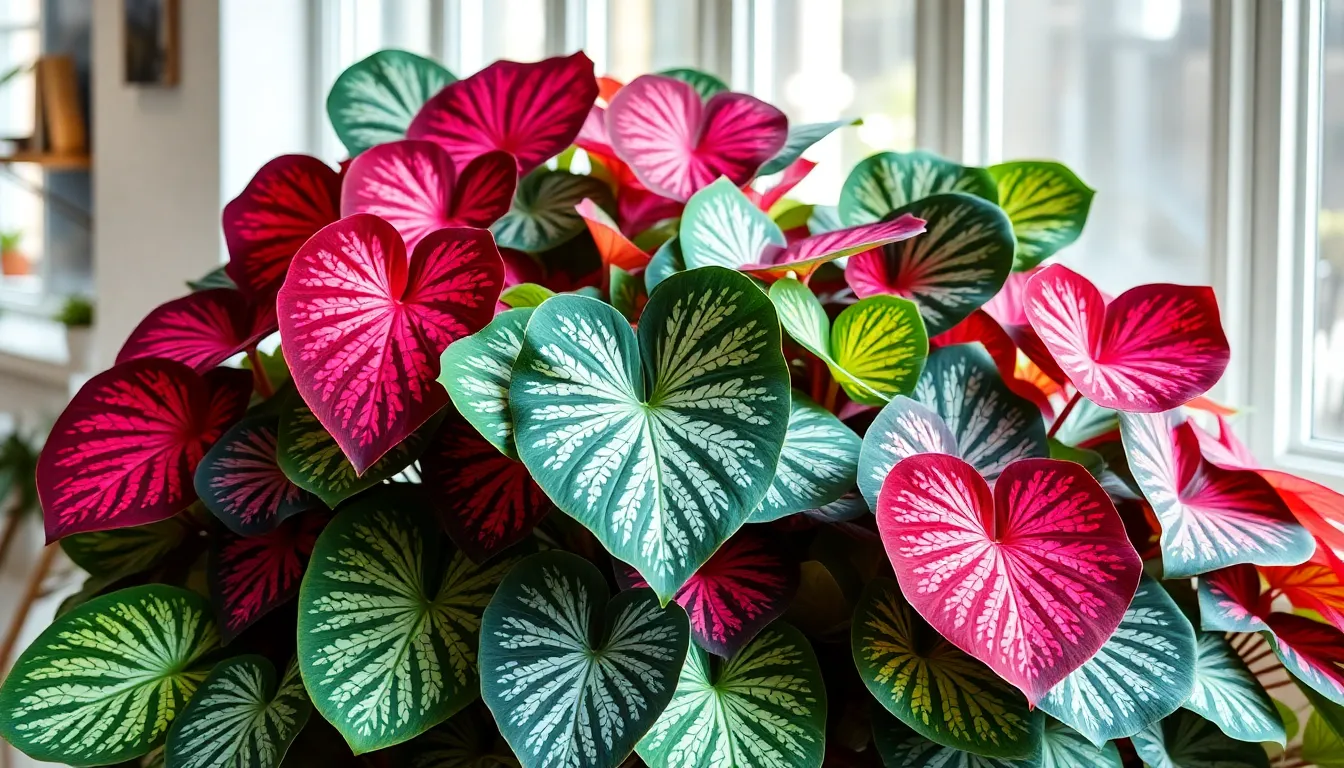
Caladiums transform any space with their stunning heart-shaped leaves that showcase vibrant colors and intricate patterns. These tropical beauties offer dramatic visual impact that complements the romantic charm we’ve explored with other heart-leafed plants.
Angel Wings Plant Varieties
Fancy-leaf caladiums display the most elaborate patterns with their large, papery heart-shaped leaves that can span up to 12 inches across. These varieties feature bold color combinations like red and green, pink and white, or burgundy and silver that create striking focal points in any room.
Strap-leaf caladiums present a more compact option with narrower heart-shaped foliage that reaches 6-8 inches in length. These varieties work perfectly for smaller spaces while still delivering the same dramatic color displays as their larger counterparts.
Dwarf varieties like ‘Mini Me’ and ‘Gingerland’ offer heart-shaped leaves in miniature form, measuring just 3-4 inches across. These petite plants excel in terrariums, dish gardens, or as accent plants alongside larger heart-leafed specimens we’ve discussed.
Seasonal Growth Patterns
Spring emergence begins when we plant caladium tubers after soil temperatures reach 70°F consistently. The heart-shaped leaves unfurl slowly over 4-6 weeks, revealing their full color potential as they mature.
Summer peak occurs during the hottest months when caladiums display their most vibrant heart-shaped foliage. During this period, the plants require consistent moisture and humidity levels above 50% to maintain their dramatic appearance.
Fall dormancy signals the end of the growing season as temperatures drop below 60°F. The colorful heart-shaped leaves gradually fade and die back, indicating it’s time to begin the storage process for next year’s display.
Tuber Storage and Replanting
Harvesting tubers should occur after the first light frost kills the foliage but before hard freezes damage the underground storage organs. We carefully dig up the tubers and brush away excess soil without washing them.
Drying process requires placing harvested tubers in a warm, dry location for 7-10 days to cure properly. This step prevents rot during storage and ensures healthy growth when we replant in spring.
Storage conditions demand temperatures between 50-60°F in a dry, well-ventilated area like a basement or garage. We store the tubers in mesh bags, paper bags, or shallow boxes filled with peat moss or vermiculite.
Replanting preparation begins in late winter when we inspect stored tubers for signs of decay or damage. Healthy tubers feel firm and show small growing points that indicate they’re ready for another season of producing those stunning heart-shaped leaves.
Begonia: Versatile Heart-Shaped Leaf Plants for Every Garden

Begonias represent one of our most beloved plant families, offering stunning heart-shaped foliage that rivals any flowering display. These adaptable plants bring both indoor charm and outdoor elegance to every gardening enthusiast’s collection.
Rex Begonia Leaf Patterns
Rex Begonias showcase some of the most spectacular heart-shaped leaves in the plant kingdom. These varieties display metallic silver patterns, deep burgundy spirals, and emerald green zones that create living artwork in any space.
Painted-leaf begonias feature intricate color combinations including pink edges with silver centers and purple veins radiating through lime green bases. Each leaf tells its own story through unique patterns that never repeat exactly.
Spiral begonias create mesmerizing whirlpool effects with their heart-shaped leaves, often combining chocolate brown centers with bright pink outer zones. We find these varieties particularly striking when grouped together in containers.
Textured varieties offer raised surfaces and velvety finishes that invite touch, while maintaining the classic heart shape that makes begonias so appealing. Popular cultivars like ‘Escargot’ and ‘Fireworks’ demonstrate how diverse these patterns can become.
Wax Begonia Growing Tips
Wax begonias thrive with consistent moisture but never waterlogged soil conditions. We recommend checking soil moisture by inserting your finger one inch deep before watering.
Light requirements vary depending on flower color, with darker blooms tolerating more sun than lighter varieties. Red and bronze leaf types handle full sun exposure, while green leaf varieties prefer morning sun with afternoon shade.
Fertilization schedules work best with balanced liquid fertilizer applied every two weeks during growing season. Dilute fertilizer to half strength to prevent burning these sensitive plants.
Pinching techniques encourage bushier growth by removing spent flowers and leggy stems. We pinch growth tips when plants reach 4 inches tall to promote branching.
Temperature preferences stay between 65°F and 75°F for optimal growth, with nighttime temperatures no lower than 50°F. Sudden temperature drops can cause leaf drop and stunted development.
Indoor and Outdoor Cultivation
Indoor begonia cultivation requires bright, indirect light near east or north facing windows. We position plants 3-4 feet from windows to prevent leaf scorch while maintaining adequate illumination.
Humidity levels should stay between 40-50% for healthy indoor growth. Place water-filled pebble trays beneath containers or group plants together to increase local humidity naturally.
Container requirements include drainage holes and well-draining potting mix enriched with perlite or vermiculite. We use containers 2 inches wider than the root ball to allow proper growth.
Outdoor cultivation works best in partial shade locations with morning sun exposure. Garden bed preparation involves amending soil with compost and ensuring proper drainage to prevent root rot.
Companion planting pairs begonias beautifully with impatiens, caladiums, and ferns in shaded garden areas. These combinations create layered displays that highlight each plant’s unique characteristics.
Seasonal care includes bringing container plants indoors before first frost or treating outdoor begonias as annuals in colder climates. We store tubers in cool, dry locations during winter months for replanting next season.
Violet: Small Heart-Shaped Leaves with Charming Flowers
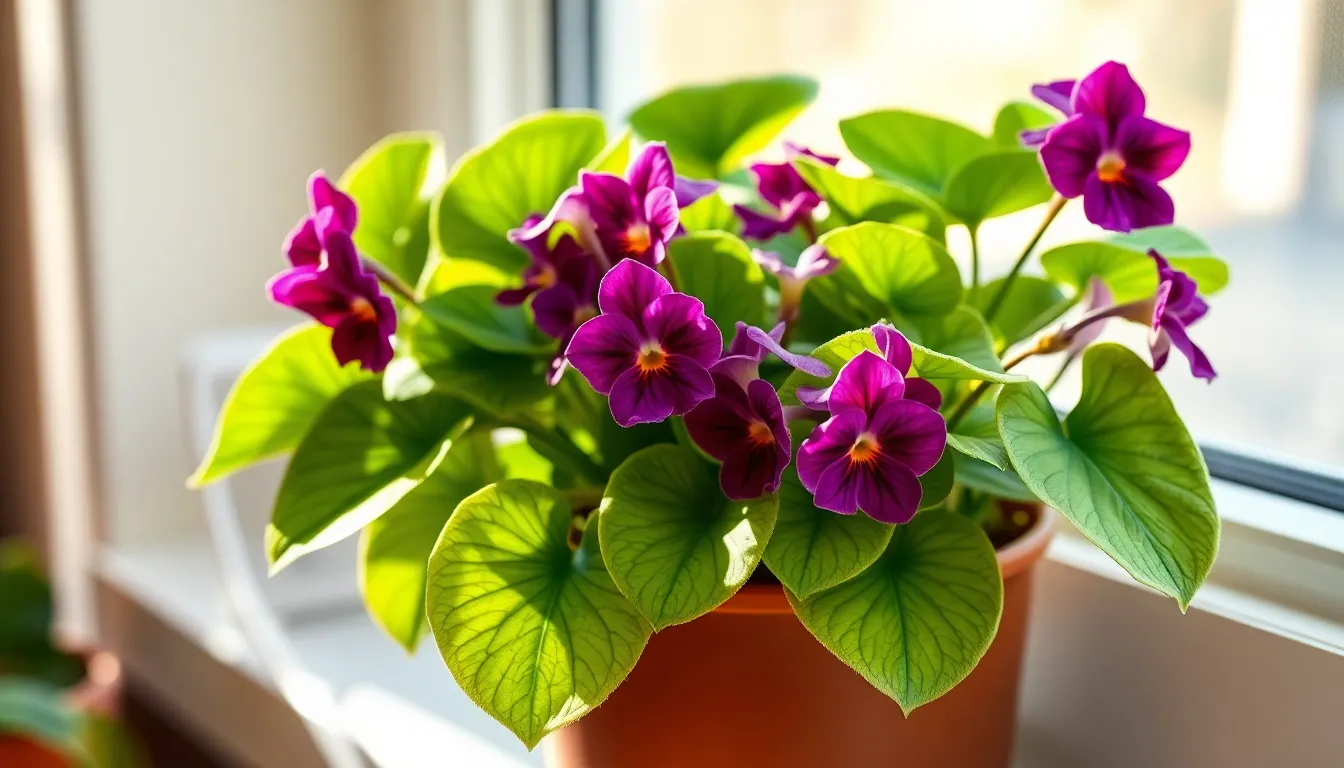
Violets bring delicate charm to our gardens with their subtle heart-shaped foliage and enchanting blooms. These petite plants offer a softer approach to heart-shaped leaf gardening compared to their more dramatic cousins.
African Violet Care Indoors
African violets thrive in our homes when we provide consistent moisture and bright, indirect light. These compact houseplants prefer temperatures between 65-70°F and humidity levels around 50%. We should water them from the bottom to avoid getting their fuzzy leaves wet, which can cause unsightly spots.
Fertilizing African violets monthly with a balanced, diluted fertilizer keeps their blooms vibrant throughout the year. We can use specialized African violet fertilizer or a general houseplant food at quarter strength. Their soil needs to drain well while retaining some moisture, so we mix equal parts peat moss, vermiculite, and perlite.
Repotting these beauties annually ensures healthy root development and continued flowering. We choose shallow pots since African violets have compact root systems. Removing spent flowers and yellowing leaves encourages new growth and maintains their tidy appearance.
Wild Violet Garden Growth
Wild violets naturalize beautifully in our outdoor spaces, creating charming groundcover in shaded areas. These hardy perennials spread through underground runners and self-seeding, forming dense mats of heart-shaped leaves. We often find them thriving under trees where other plants struggle.
Planting wild violets in partial to full shade provides the ideal growing conditions for these woodland natives. They prefer moist, well-draining soil rich in organic matter. We can add compost or leaf mold to improve soil structure and fertility.
Managing wild violet spread requires occasional division every 2-3 years to prevent overcrowding. We divide clumps in early spring or fall when temperatures are cooler. Their edible flowers and leaves make excellent additions to salads and teas during harvest season.
Propagation Methods
Propagating African violets through leaf cuttings gives us new plants identical to the parent variety. We select healthy, mature leaves from the middle row and cut them with a sharp, clean knife. The leaf stem should be about 1 inch long for optimal rooting success.
Rooting violet leaf cuttings in water or moist potting mix produces plantlets within 6-8 weeks. We place the cut end in our chosen medium and maintain consistent moisture without waterlogging. Small plantlets develop at the base of the leaf stem once roots establish.
Dividing mature African violet crowns creates multiple plants from established specimens. We carefully separate the crown sections, ensuring each division has roots attached. This method works best during repotting when we can assess the plant’s root system thoroughly.
Morning Glory: Heart-Shaped Leaves on Climbing Vines

Morning glories offer gardeners a perfect combination of romantic heart-shaped foliage and spectacular climbing ability. These fast-growing annual vines create stunning vertical displays while providing the charming cordate leaves we’ve been exploring throughout our plant collection.
Ipomoea Varieties and Colors
Ipomoea purpurea stands out as the classic choice for gardeners seeking deep purple or vibrant blue trumpet-shaped blooms. Ipomoea tricolor captures attention with its famous ‘Heavenly Blue’ variety, producing large sky-blue flowers that complement the heart-shaped leaves beautifully. Ipomoea nil provides the widest range of possibilities, offering flowers in pink, red, white, and even striped patterns.
Each variety maintains the characteristic broad, cordate leaves that create lush green backdrops for the colorful blooms. Purple varieties pair exceptionally well with cottage garden themes, while blue selections complement modern industry designs. White flowering types brighten shaded areas and provide elegant contrast against darker support structures.
Trellis and Support Systems
Vertical support structures become essential for morning glories to reach their full potential of 10-15 feet in height. Trellises made from wood, metal, or bamboo provide ideal climbing surfaces for the twining stems. Fences offer ready-made support systems that morning glories can quickly transform into living walls of heart-shaped foliage.
Pergolas create overhead canopies when morning glories climb upward, providing natural shade structures for outdoor spaces. Arbors frame garden entrances beautifully as the vines weave through the framework. String or wire systems work effectively for budget-conscious gardeners who want to create custom climbing arrangements.
Installing supports before planting ensures the young vines have immediate structure to follow. Sturdy construction prevents collapse under the weight of mature plants laden with leaves and flowers.
Annual Growing Cycle
Direct sowing after the last frost gives morning glories the best start in temperate climates. Seeds germinate within 7-14 days when soil temperatures reach consistent warmth. Spring planting allows these fast-growing vines to establish strong root systems before summer heat arrives.
Summer months bring peak growth and flowering, with adequate sunlight and water supporting rapid vertical expansion. Regular watering keeps the heart-shaped leaves lush and promotes continuous blooming. Fall extends the flowering season until the first frost naturally ends the annual cycle.
Winter preparation involves collecting seeds from spent flowers for next year’s plantings. Removing dead vines prevents disease issues and prepares support structures for the following season’s growth.
Sweet Potato Vine: Ornamental Heart-Shaped Leaves for Landscapes
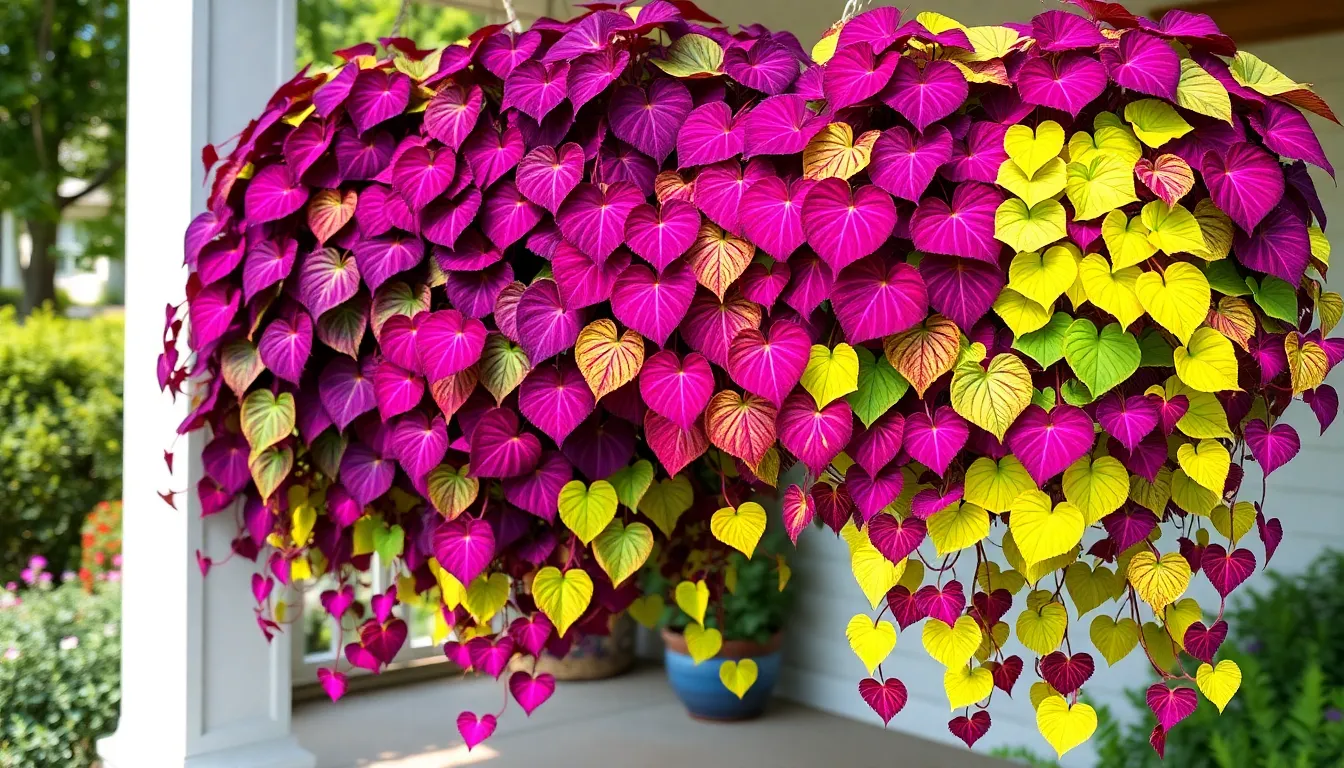
Sweet potato vines bring distinctive charm to landscapes with their cascading growth and attractive foliage. We’ll explore how these versatile plants create stunning visual displays while offering practical gardening answers.
Decorative Varieties vs Edible Types
Ornamental sweet potato vines excel in industry design with their vibrant foliage colors ranging from deep purple to bright chartreuse. These decorative varieties like ‘Blackie’ and ‘Margarita’ focus energy on producing stunning leaves rather than developing large tubers. Edible sweet potato varieties prioritize underground tuber development for harvest purposes.
Decorative types spread rapidly across garden beds and containers, creating dense ground cover within a single growing season. Gardeners choose ornamental cultivars specifically for their ability to fill spaces quickly with colorful trailing stems. Edible varieties require more structured growing conditions and dedicated garden space for proper tuber formation.
Container Gardening Applications
Container cultivation showcases sweet potato vines’ trailing nature perfectly in hanging baskets and elevated planters. We recommend using containers at least 12 inches wide to accommodate their vigorous spreading habit. These plants create dramatic spillover effects when positioned along deck railings or porch edges.
Mixed container arrangements benefit from sweet potato vines as thriller plants that cascade over pot edges. Their rapid growth fills containers within 4 to 6 weeks during peak growing season. Regular watering becomes essential since containers dry out faster than ground plantings, especially during hot summer months.
Window boxes transform with sweet potato vines’ ability to trail 3 to 4 feet beyond container edges. We suggest pairing them with upright plants like coleus or impatiens for balanced compositions.
Seasonal Color Changes
Summer growth produces the most vibrant foliage colors as sweet potato vines respond to warm temperatures and extended daylight. Purple varieties deepen to almost black coloration during peak heat periods. Chartreuse and lime green cultivars maintain their bright appearance throughout the growing season.
Cool weather triggers subtle color shifts as temperatures drop below 60°F consistently. Some varieties develop bronze or copper undertones before frost kills the tender foliage. These seasonal transitions create ever-changing industry interest from spring through fall.
First frost ends the growing season abruptly, causing all foliage to blacken and collapse. We recommend harvesting any ornamental tubers before hard freeze if you want to overwinter them indoors for next year’s planting.
Redbud Tree: Heart-Shaped Leaves on Beautiful Flowering Trees
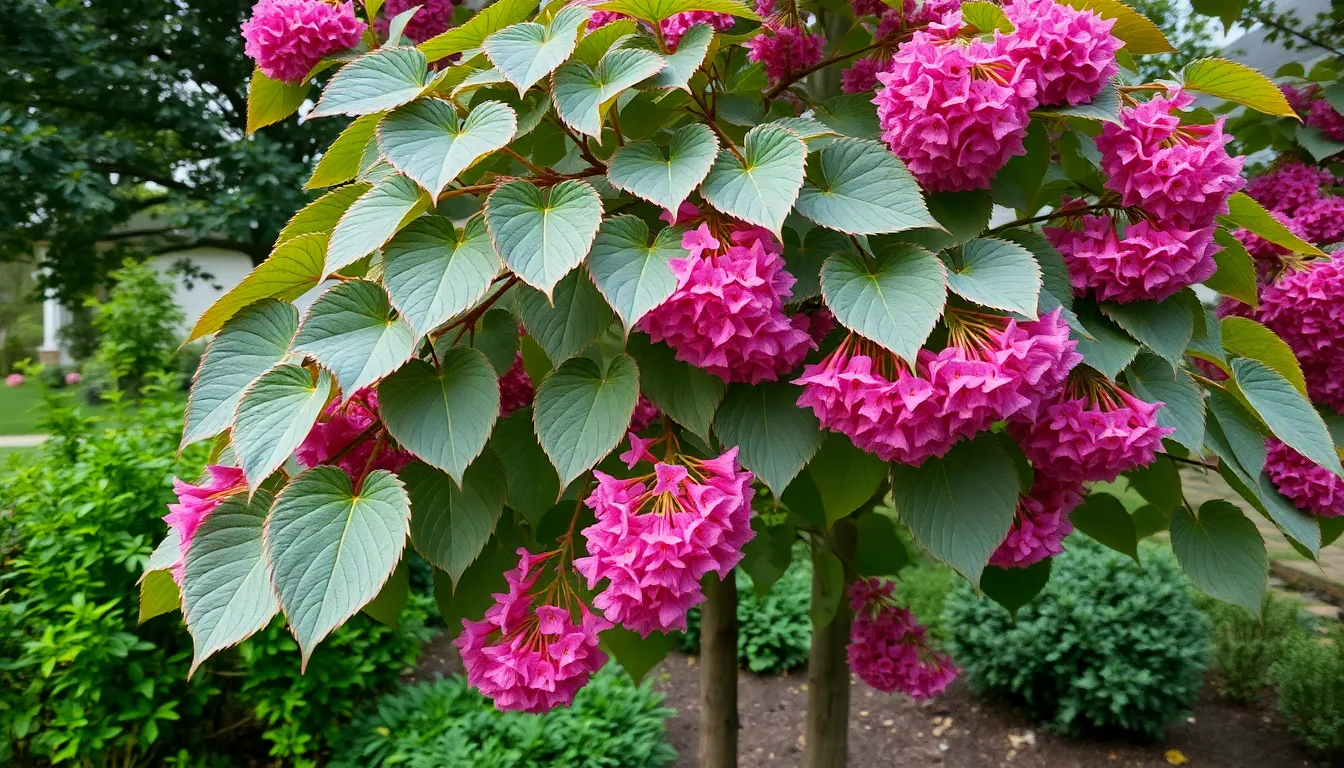
Moving from smaller houseplants to outdoor specimens, we discover the Eastern Redbud as a stunning native tree that combines heart-shaped foliage with spectacular spring blooms.
Eastern Redbud Characteristics
Eastern Redbuds showcase distinctive heart-shaped (cordate) leaves that measure 3-5 inches across and create dense, lush canopies throughout the growing season. Gray-green foliage emerges after the tree’s famous pink to purple flowers bloom directly on branches and trunks in early spring. Mature trees typically reach 20-30 feet in both height and width, making them perfect understory specimens for residential landscapes.
Adaptability defines the Eastern Redbud’s growing preferences, as these native North American trees thrive in partial shade while tolerating full sun conditions. Well-drained, fertile soils provide optimal growing conditions, though redbuds adapt to various soil types found in urban and suburban environments. Their compact size and resilient nature make them ideal choices for gardeners seeking low-maintenance flowering trees with distinctive heart-shaped leaves.
Industry Design Applications
Specimen plantings allow Eastern Redbuds to serve as stunning focal points in front yards, where their heart-shaped leaves and spring flowers create dramatic visual impact. Woodland gardens benefit from redbuds’ natural understory growth habit, as they complement larger shade trees while providing seasonal interest. Border plantings along property lines or walkways showcase the trees’ ornamental value through multiple seasons.
Urban environments particularly benefit from redbuds’ compact size and pollution tolerance, making them excellent street trees or courtyard specimens. Mixed plantings with other native species create naturalized landscapes that support local wildlife while maintaining year-round visual appeal. Container growing isn’t recommended for mature specimens, though young redbuds can start in large planters before transplanting to permanent locations.
Seasonal Interest and Fall Colors
Spring flowering occurs before leaf emergence, creating stunning displays of pink to purple blooms that cover entire branches from February through April depending on climate zone. Heart-shaped leaves unfurl after flowering, providing dense summer shade with their gray-green color and distinctive cordate shape. Fall transformation brings vibrant yellow foliage that creates striking autumn displays before leaves drop for winter dormancy.
Wildlife benefits extend throughout seasons, as early spring flowers provide nectar for pollinators when few other plants are blooming. Seed pods develop after flowering, offering food sources for birds while adding textural interest to winter landscapes. Four-season appeal makes Eastern Redbuds valuable investments for homeowners seeking trees that provide continuous industry interest through their heart-shaped leaves and seasonal changes.
Conclusion
Heart-shaped leaves bring an undeniable charm and emotional warmth to our gardens that’s hard to replicate with other foliage shapes. From the low-maintenance Pothos that’s perfect for beginners to the dramatic outdoor presence of Eastern Redbud trees we’ve explored how these plants can transform any space into something truly special.
Whether you’re drawn to the vibrant blooms of Anthurium the cascading beauty of Sweet Potato Vine or the seasonal magic of Cyclamen there’s a heart-leafed plant that’ll suit your gardening style and experience level. These living symbols of love and connection offer us the perfect way to bring nature’s romance indoors and out.
We encourage you to start your own heart-shaped plant collection and discover firsthand how these botanical treasures can create lasting joy in your daily life.
Frequently Asked Questions
What are the most beginner-friendly heart-shaped leaf plants?
Pothos (Epipremnum aureum) is the ideal starter plant, requiring minimal care and adapting to various lighting conditions. Philodendron hederaceum is another excellent choice with cascading vines and low maintenance needs. Both plants are forgiving with watering schedules and can thrive in most indoor environments, making them perfect for new plant parents.
How do I care for Anthurium plants indoors?
Anthuriums need bright, indirect light and high humidity levels to thrive. Water when the top inch of soil feels dry, and maintain temperatures between 65-80°F. Use well-draining potting mix and mist regularly or use a humidity tray. Feed monthly with diluted fertilizer during growing season for optimal blooms.
Can heart-shaped leaf plants grow outdoors?
Yes, many varieties thrive outdoors. Morning Glory vines create beautiful climbing displays, while Sweet Potato Vines work well in containers and landscapes. Hardy Cyclamen species can naturalize in garden beds. Eastern Redbud trees provide spectacular spring blooms and heart-shaped foliage for larger outdoor spaces.
What makes Caladium plants special for indoor decor?
Caladiums offer dramatic color combinations with heart-shaped leaves featuring vibrant patterns in pink, red, white, and green. Their bold foliage creates striking focal points in any room. They’re perfect for adding artistic flair and seasonal interest, though they require dormancy periods and tuber storage during winter months.
How often should I water heart-shaped leaf houseplants?
Most heart-leafed houseplants prefer the “soak and dry” method – water thoroughly when the top 1-2 inches of soil feel dry. Pothos and Philodendrons can tolerate slight drought, while Anthuriums need consistent moisture. Begonias require more frequent watering, and African Violets need consistent but not soggy conditions.
Which heart-shaped plants produce flowers?
Several varieties bloom beautifully: Anthuriums produce waxy, colorful spathes; Cyclamen offer delicate seasonal flowers; African Violets bloom continuously with proper care; Begonias display various flower forms; and Morning Glories produce vibrant trumpet-shaped blooms. Each requires specific conditions to encourage flowering.
Are heart-shaped leaf plants suitable for low-light conditions?
Pothos and Heartleaf Philodendrons adapt well to lower light situations, though growth may slow. Most heart-leafed plants prefer bright, indirect light for optimal health and color development. Varieties with colorful foliage like Caladiums and variegated Pothos need more light to maintain their patterns.
How do I propagate heart-shaped leaf plants?
Most varieties propagate easily through stem cuttings placed in water or soil. Pothos and Philodendrons root quickly in water. African Violets can be propagated from leaf cuttings, while Begonias use stem or leaf cuttings. Some plants like Cyclamen grow from bulbs, and Morning Glories from seeds.

